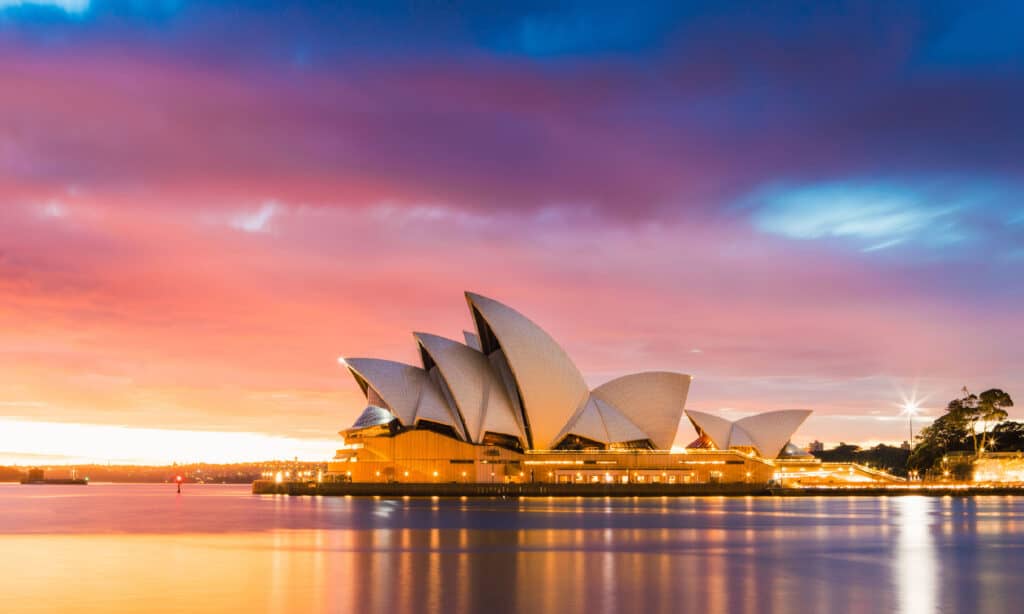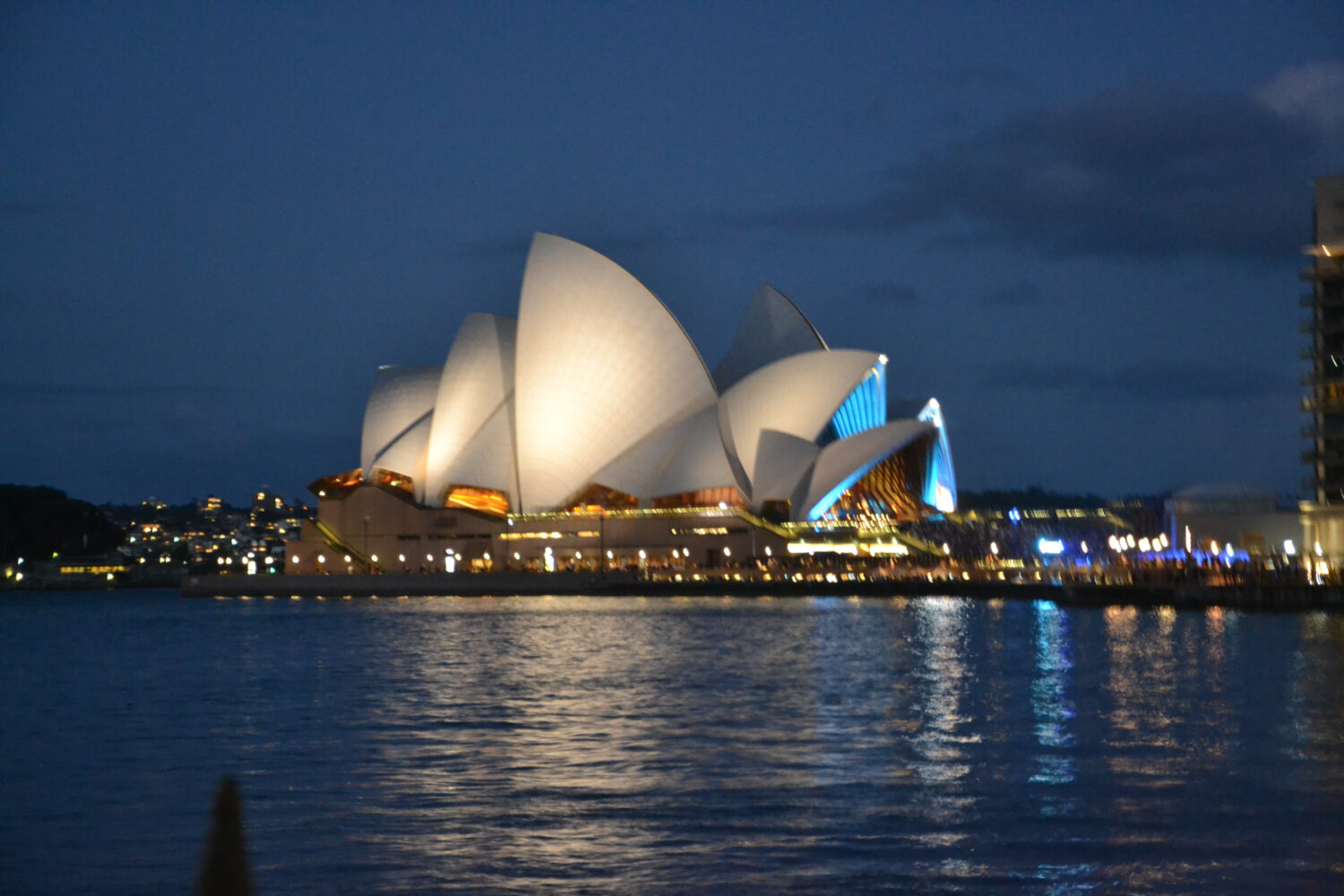Discover How and Why the Sydney Opera House Was Built
The Sydney Opera House is one of the most recognizable pieces of architecture in the entire world. Located on Bennelong Point in Sydney, Australia, the Sydney Opera House remains one of the most popular places to visit in Australia. The opera house hosts over 8 million visitors each year, many of whom are coming to take in a show on one of the several performance stages.
The history of the Sydney Opera House is endlessly fascinating. Read on to understand why, and more interestingly, how this incredible architectural feat came to be. It wasn’t easy, nor was it cheap, but the result is incredible. The Sydney Opera House now sits on UNESCO’s World Heritage Site list, which is a massive accomplishment for the thousands of folks who worked to construct the building.
Why Was the Sydney Opera House Built?

©iStock.com/ai_yoshi
The Sydney Opera House was born out of a community desire for a larger performance venue in town. In the 1940s, Eugene Goossens, Director of the New South Wales State Conservatorium of Music, wanted a larger performing arts space. Shows were being performed in the town hall of Sydney, and the space was not as large as Goossens and the community desired. Thus, an idea was born that would take decades to come into action.
In 1954, Goossens’ idea was finally heard by someone who could bring the dream into reality. Joseph Cahill, the Premier of New South Wales, brought the project to its first step: creating a design. Once some support was garnered, Goossens also propositioned that the building be constructed on Bennelong Point. Ultimately, his desired location was selected for the project, despite some initial resistance from Cahill.
The Design of the Sydney Opera House
In order to build the Sydney Opera House, it needed a design! Joseph Cahill held an international design contest in search of a creative design for the opera house. The contest began on September 13, 1955. Over two hundred applicants entered the contest and the architects were from all over the world. The contest specifications were fairly open, describing the number of people who needed to fit the venue and suggesting that it include multiple performance areas.
The contest didn’t conclude until 1957. 233 architects sent in designs and, ultimately, Jørn Utzon of Denmark took first place. His work was, apparently, in the reject pile and then reassessed. The prize for the winning design was 5,000 Australian pounds which, all things considered, is not much for designing one of the most famous buildings in the world!
Despite winning the design contest, Utzon was not the leading architect for the project. Peter Hall of Australia constructed a team that brought the building to life. Utzon’s designs won the esteem they deserved, however, and Utzon received the Pritzker Architecture Prize in 2003 for his incredible work. The Pritzker Architecture Prize is the highest-esteemed award an architect can receive.
The Construction of the Sydney Opera House

©Lithuaniakid/Shutterstock.com
The construction of the Sydney Opera House turned out to be a very difficult process. It took place in multiple stages, and the entire project took fourteen years to complete. The architectural team estimated that the construction of the opera house would take four years, so clearly there were some hang-ups.
Not only did construction take way longer than anticipated, but the project went far over budget. Estimates stated that the project would cost around $7 million. In the end, the Sydney Opera House cost $102 million to construct.
Construction took place in four stages and the construction team consisted of over 10,000 workers. Each stage was a massive undertaking with unique specifications. As the project evolved, the design evolved as well, and some major changes to Utzon’s original design occurred. For one, the architectural team completely tossed his concept for the interior seating setup. He had also pitched the major hall to be fit for many purposes, but the large performance space evolved to be solely a concert hall.
Stage 1: The Podium
The first stage of building the Sydney Opera House was the construction of the podium. This portion of the project began in 1959 but faced significant delays. Utzon hadn’t completed the final designs and large structural issues were springing up, remaining unresolved. The first portion of construction, then, was totally rushed. Thus, workers made errors during construction that had to be corrected and rebuilt later on in the process.
Stage 2: The Roof
The next stage of construction was to be the construction of the roof. The roof is one of the most iconic parts of this building, and bringing it to life was a massive undertaking. A lot of research went into finding the most economical way to approach the roof. 11 designs were drafted and scrapped before the twelfth idea finally stuck.
Before the roof was constructed in Sydney, it was tested in wind tunnels at the University of Southhampton. The architects wanted to ensure that the roof was strong and durable. The roof we see today has over a million tiles on it. This stage of the process cost millions and millions of dollars, but the total costs of the project were still under $23 million.
Stage 3: The Interior
The interior of the Sydney Opera House was the next project the team focused on. This portion of the project started in 1963 when Utzon relocated to Sydney to aid more directly in the process. The design and execution of the interior was the most expensive stage of the construction of the Sydney Opera House. It cost $56 million to bring the inside of the building to life.
This stage of the building process was tumultuous for more than a few reasons. While design and construction snags occurred, there was also a shift in the project’s jurisdiction. When the Ministry of Public Works took over the construction of the Opera House, criticism pushed Utzon to resign from the project only three years after relocating.
The Opening
Finally, after fourteen years of construction, the Sydney Opera House was ready for its grand opening in 1973. The costs of the project were immense, but the world was ready and eager to see what had taken place at Bennelong Point. Queen Elizabeth II flew to Sydney to lead the opening ceremony, and many were in attendance. The grand opening of the opera house was also televised, with folks tuning in from all over to celebrate.
The Sydney Opera House Today

©anek.soowannaphoom/Shutterstock.com
Can You Just Go Inside the Sydney Opera House?
Sort of. You can’t just wander into the Sydney Opera House unannounced. However, you can snag a tour around the facility, or purchase tickets to a show. Tours and shows are great opportunities to observe the phenomenal architecture of the Sydney Opera House. If you want to learn more about the history, a tour will be your best bet.
How to See a Show at the Sydney Opera House
Check out the Sydney Opera House calendar for a peek at current events going on at the Opera House. There’s sure to be a show that tickles your fancy! The Sydney Opera House puts on ballets, concerts, operas, theatrical performances, and more. They also host classes and events, so if you’re looking to take a class or even sit on the steps and sketch the building, keep checking the calendar!









